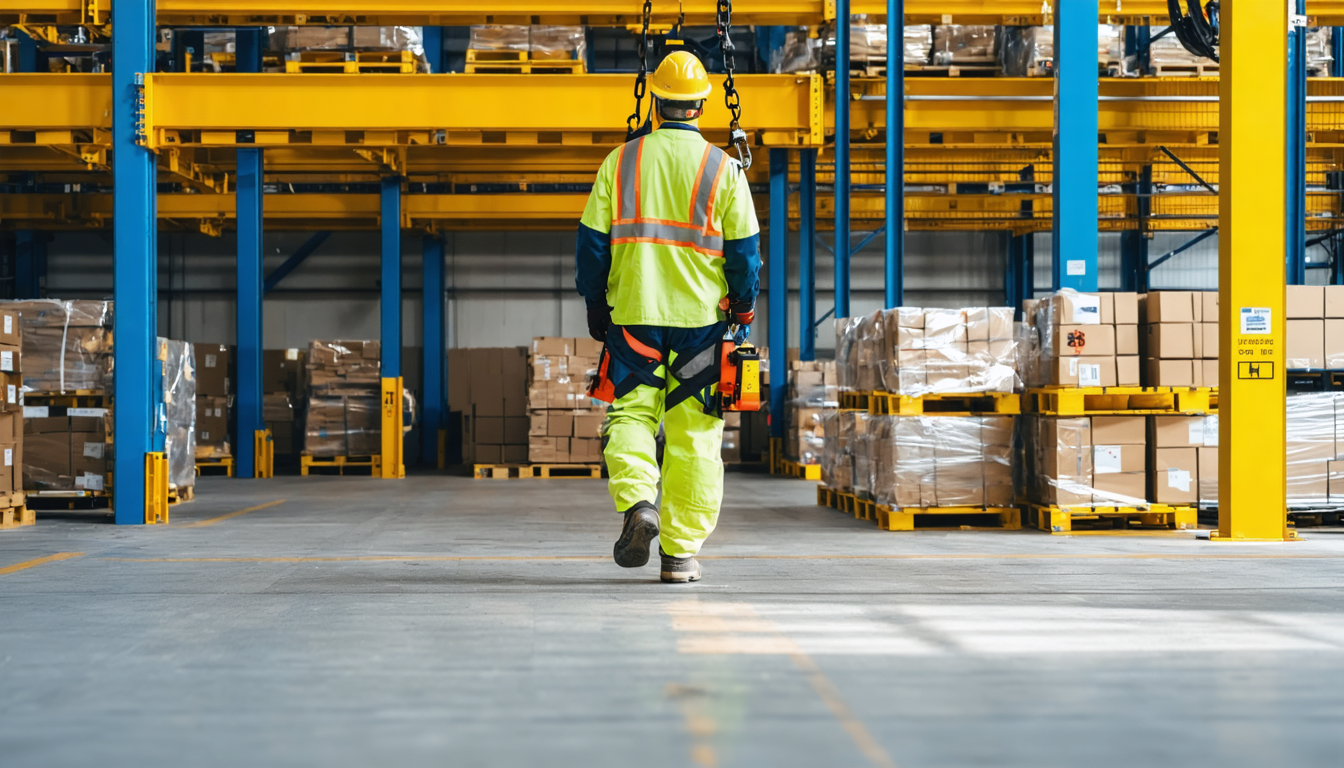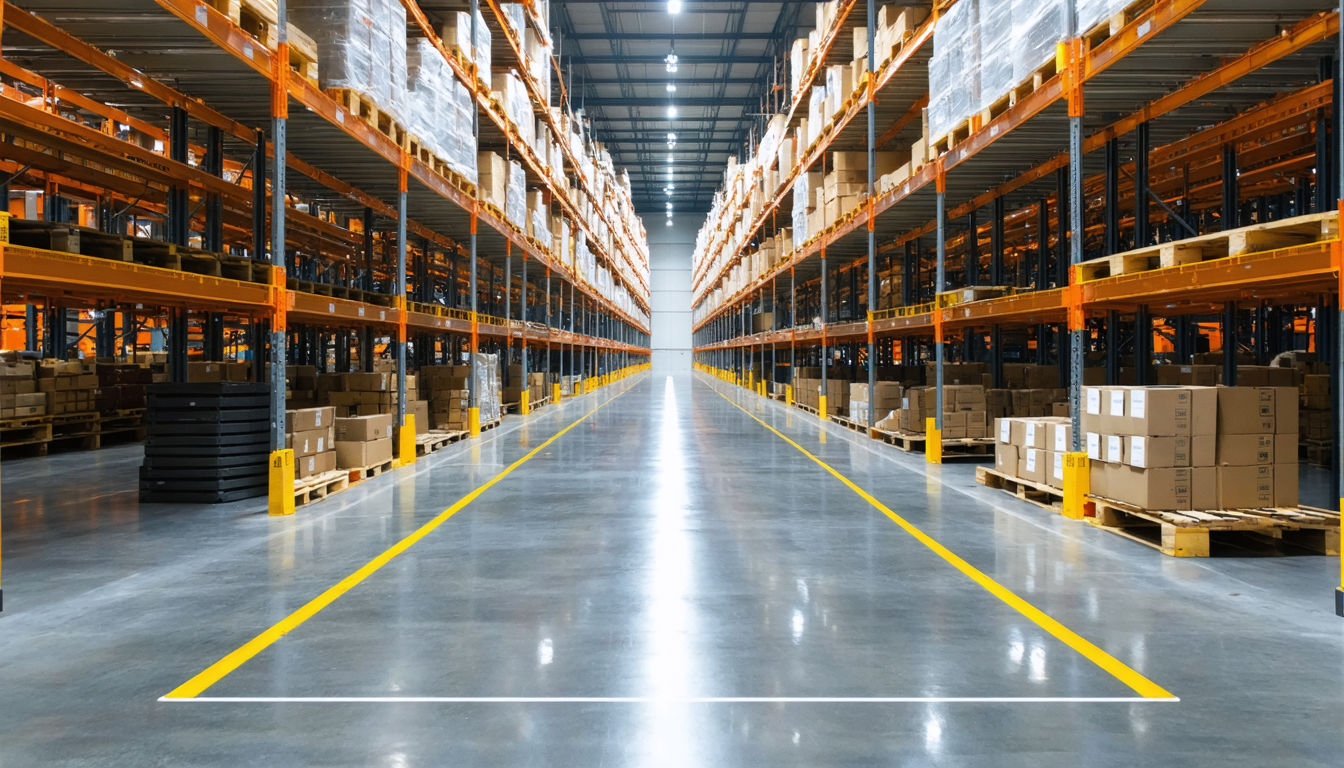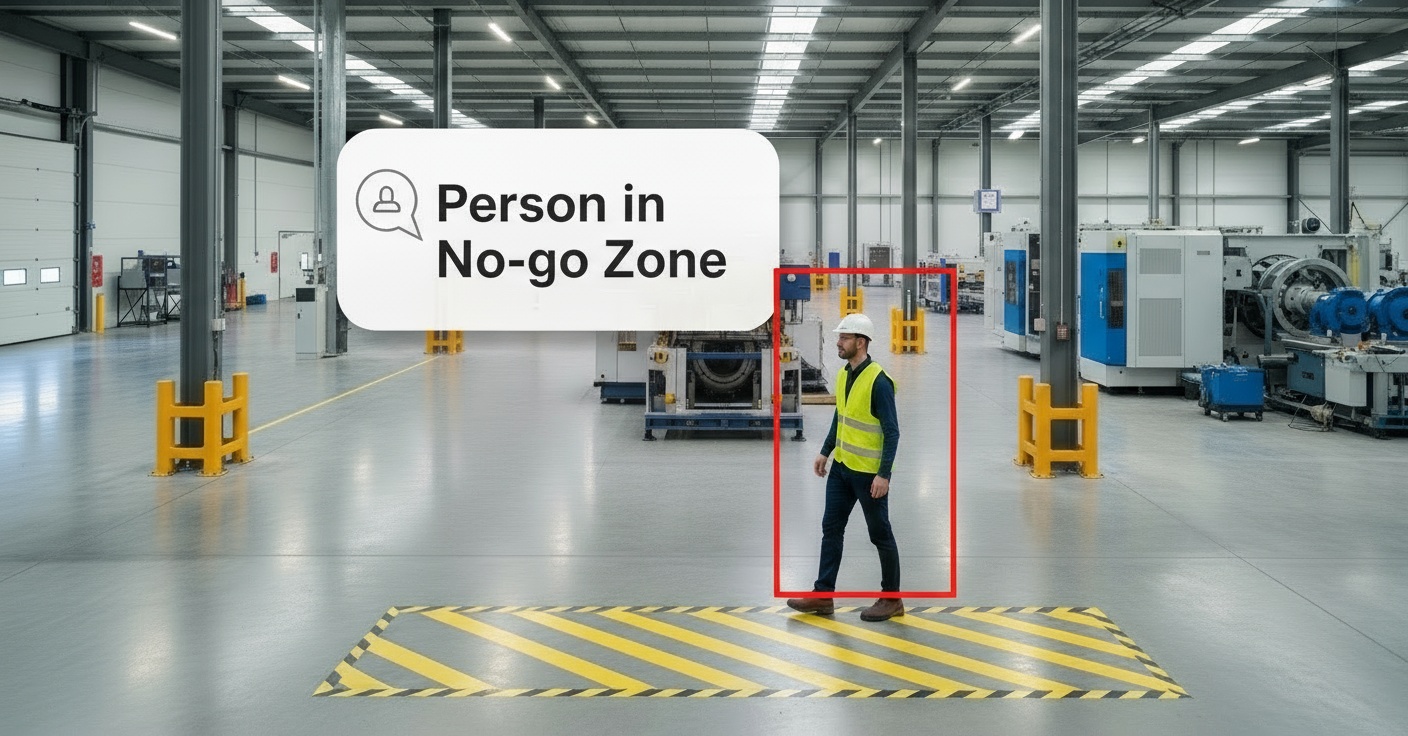Every year, thousands of warehouse workers experience injuries on the job—and some of the most severe are caused by being caught in or crushed by machinery. For example, forklift accidents are a major and costly source of injuries in U.S. warehouses. But here’s the good news: the risks that lead to many of these injuries can be mitigated. When organizations combine proven safety protocols with technology like video AI, they move from reacting after an incident to anticipating and addressing risks to reduce the likelihood of the next one. This guide breaks down the true costs, root causes, and provides a clear framework for moving from a reactive to a forward-looking safety model using current technology.
Why caught-in or crushed by machinery accidents are so costly in warehousing
Caught-in or crushed by machinery incidents are among the most disruptive and expensive safety issues in warehousing. These events often involve powered industrial vehicles, conveyors, and heavy objects—equipment found in every busy warehouse.
The numbers tell the story:
-
Warehouse workers face a high risk of injury, with many incidents being serious enough to require considerable time away from work.
-
Forklift-related incidents are among the most hazardous and costly, with individual claims often running into tens of thousands of dollars.
-
Conveyor systems are a frequent source of workers’ compensation claims, often involving severe crush injuries and amputations.
The impact extends beyond claims and medical bills. Every caught-in or crushed-by incident can lead to a series of indirect costs: downtime, rerouting workflows, lost productivity, and increased insurance premiums. A single serious accident can lead to substantial financial consequences once all factors are included.
And beyond the financials, these events erode trust, disrupt teams, and can put an organization’s OSHA compliance record—and reputation—at risk.
The top 5 causes of caught-in or crushed by machinery accidents in warehousing—and how to guard against them
Understanding the real-world causes behind these incidents is the first step to mitigating them. Let’s break down the five leading causes, how traditional safety measures work, and how video AI can strengthen your safety program.
1. Unsafe Operation of Powered Industrial Vehicles
The Hazard:
In one scenario, a warehouse associate steps off a stand-up forklift before it comes to a complete stop, intending to reposition a load. The forklift continues to roll, pinning the worker’s foot between the vehicle and a storage rack. These situations are common when operators or pedestrians let their guard down around moving equipment.
Traditional Safeguards:
-
OSHA-mandated operator training and certifications.
-
Strict enforcement of seat belt and body restraint policies.
-
Visual and audible alerts (horns, alarms) in high-traffic zones.
-
Marked pedestrian walkways and exclusion zones.
How AI Strengthens Safeguards:
video AI can detect when a forklift enters a no-go zone, helping to reduce the risk of incidents with pedestrians. Real-time alerts let supervisors intervene when a risky situation is detected. By automatically flagging risky vehicle-pedestrian interactions, safety leaders get the data they need to adjust workflows, retrain staff, and reinforce protocols—without waiting for an incident report.
2. Failure to Lock Out/Tag Out (LOTO) During Maintenance
The Hazard:
A technician removes the guard on a live conveyor belt for a quick fix, thinking “it’ll only take a minute.” As they reach into the moving mechanism, their glove is caught by the chain drive, resulting in a finger amputation. Incidents like this are frequently traced to skipped LOTO procedures.
Traditional Safeguards:
-
Written LOTO procedures and mandatory training.
-
Regular audits of LOTO compliance, especially during shift changes.
-
Supervisor sign-off before equipment is serviced.
How AI Strengthens Safeguards:
video AI can monitor for missing personal protective equipment and flag unauthorized access to restricted or dangerous zones. With real-time alerts, EHS teams are notified swiftly when LOTO protocols—or other safety measures—are bypassed. Event footage provides a clear record for investigation, root cause analysis, and retraining.
3. Inadequate Machine Guarding
The Hazard:
During a busy shift, a worker notices that the guard on a conveyor’s pinch point is missing but continues operating the machine to keep up with demand. Later, while clearing a minor jam, their hand is caught between the moving belt and roller. Lack of guarding remains one of the leading contributors to crush and amputation injuries.
Traditional Safeguards:
-
Routine inspections for missing or damaged guards.
-
Signage and physical barriers highlighting dangerous zones.
-
Disciplinary policies for bypassing or removing guards.
How AI Strengthens Safeguards:
video AI can monitor for people entering no-go zones or loitering near hazardous equipment. When someone is detected in a restricted area, supervisors are alerted. This forward-thinking approach helps reduce unsafe shortcuts and maintains high standards for guarding—even during peak periods.
4. Unsafe Manual Handling of Heavy Objects

The Hazard:
A worker attempts to reposition a heavy dock plate by hand instead of using a mechanical assist. Their hand slips, and the plate drops, crushing their fingers between metal surfaces. Manual object handling near heavy equipment often leads to hand, finger, and foot injuries.
Traditional Safeguards:
-
Training on proper lifting techniques and team lifts.
-
Use of mechanical aids (hoists, lift assists) for heavy items.
-
PPE requirements such as steel-toed boots and gloves.
How AI Strengthens Safeguards:
video AI can spot missing PPE, detect when people are present in unsafe areas, and flag loitering or crowding near heavy equipment. By surfacing these patterns, safety leaders can address risky behaviors to reduce the likelihood of injury, reinforce the use of mechanical aids, and ensure that PPE policies are followed.
5. Poor Traffic Management and Pedestrian Safety

The Hazard:
A worker moves quickly between aisles to keep up with orders, unaware that a forklift is turning into the same aisle. Without clear line-of-sight, the two collide, pinning the worker’s leg. Crowded warehouses, unclear walkways, and uncoordinated vehicle movement increase the risk of these incidents.
Traditional Safeguards:
-
Marked pedestrian zones and crossing points.
-
Traffic flow planning and designated travel routes.
-
Pedestrian awareness training and mirrors at blind spots.
How AI Strengthens Safeguards:
video AI identifies people and vehicles entering no-go zones, track crowding in high-traffic areas, and signal when forklifts are operating outside designated paths. Automated incident detection means safety teams can analyze adjust routes, and optimize schedules—making real, data-driven improvements to warehouse layouts and workflows.
Integrating a video AI platform: from NVR to operational insights in warehousing
Many warehouse operations already have some form of camera system or NVR (Network Video Recorder), but these traditional systems are reactive—they only provide footage after something’s gone wrong. Upgrading to a video AI platform moves safety from a passive cost center to an insight-driven tool for strengthening compliance and operations.
How It Works:
-
Seamless Integration: Capable video AI platforms are designed to work with your existing infrastructure—including common Power over Ethernet (PoE) cameras. No need for expensive “rip-and-replace” projects.
-
Cloud-Native Storage: By bridging your on-prem cameras to a secure, cloud-native dashboard, you eliminate bulky on-site servers and get scalable, reliable video storage.
-
AI Analysis Layer: An AI layer analyzes your video feeds. Instead of manual review, AI surfaces critical events—such as people in no-go zones, missing PPE, or vehicles in restricted areas—automatically.
-
Unlimited User Access: With a unified dashboard and unlimited user seats, safety, operations, and IT teams can collaborate seamlessly from a single source of information.
-
Scalable and Low Maintenance: Remote updates and centralized management streamline IT operations. Adding new cameras or locations becomes a straightforward process.
Here’s how it compares at a glance:
Feature |
Traditional NVR System |
Video AI platform |
|---|---|---|
Camera Compatibility |
Often requires new hardware |
Works with existing PoE cameras |
Storage |
On-prem, limited |
Secure, cloud-native, scalable |
Maintenance |
Frequent, on-site |
Minimal, remote updates |
User Access |
Limited, siloed |
Unlimited users, unified dashboard |
Video Review |
Manual, slow |
video AI-powered search & detection |
Actionable Insights |
Passive footage |
Automated alerts & analytics |
A cloud-based video AI solution helps warehouse teams significantly reduce incident investigation time, enforce OSHA compliance, and create a safer, more accountable workplace.
Practical tips for warehousing leaders
-
Evaluate Your Current Camera Coverage: Identify high-risk zones—forklift aisles, dock areas, conveyor lines—and ensure they are in view.
-
Prioritize AI Capabilities: Look for platforms that detect vehicles in no-go zones, PPE compliance, and restricted area breaches.
-
Plan for Collaboration: Choose solutions that offer unlimited user access so safety, ops, and IT can work together.
-
Integrate with Safety Protocols: Use video AI data to support incident investigations, training, and improvement cycles.
See video AI in action for warehouse safety
Discover how Spot AI’s video AI platform can help your team reduce risk, accelerate investigations, and support a safer workplace. Experience the platform’s capabilities firsthand and explore how it integrates with your existing safety protocols.
Frequently asked questions
What are the most common causes of caught-in or crushed by machinery injuries in warehousing?
The top causes include unsafe operation of forklifts and pallet jacks, failure to follow lockout/tagout procedures during maintenance, inadequate machine guarding, unsafe manual handling of heavy objects, and poor traffic management in high-density areas.
How can current safety technology be implemented in an existing warehouse without replacing all cameras?
video AI platforms are designed to work with your current camera infrastructure, including standard PoE cameras. They overlay analytics on your existing feeds, so you can upgrade to anticipatory safety monitoring without a complete hardware overhaul.
What are best practices for integrating video AI into a warehouse safety program?
Start with a risk assessment to identify high-priority areas. Engage both IT and safety teams early in the process. Choose a platform that offers real-time alerts, unlimited user seats, and open APIs for integration with your incident management systems.
How does video AI help with OSHA compliance?
video AI supports OSHA compliance by continuously monitoring for key violations—like forklifts in pedestrian zones or missing PPE. Automated alerts and searchable video archives make it easy to investigate incidents and document compliance actions.
What training is needed for teams to use video AI effectively?
Most frontline teams can use cloud-based video AI dashboards with minimal training. It’s best practice to run onboarding sessions for safety leaders and supervisors, focusing on incident review workflows and how to respond to real-time alerts.
How can safety technology help reduce stress for safety leaders?
video AI automates hazard detection and reporting, freeing safety managers from tedious video review and manual monitoring. This lets them focus on coaching, process improvement, and building a strong safety culture.
How to choose the best video monitoring system for warehouse safety?
The 'best' system is one that aligns with your operational needs. Key features to evaluate include: compatibility with your existing cameras to avoid costly replacements, a cloud-native platform for secure access from anywhere, AI detections relevant to your specific risks like no-go zone breaches, and unlimited user seats to foster collaboration between safety, operations, and IT teams on a unified dashboard.
About the author
Joshua Foster
IT Systems Engineer, Spot AI
Joshua Foster is an IT Systems Engineer at Spot AI, where he focuses on designing and securing scalable enterprise networks, managing cloud-integrated infrastructure, and automating system workflows to enhance operational efficiency. He is passionate about cross-functional collaboration and takes pride in delivering robust technical solutions that empower both the Spot AI team and its customers.

























.png)
.png)
.png)